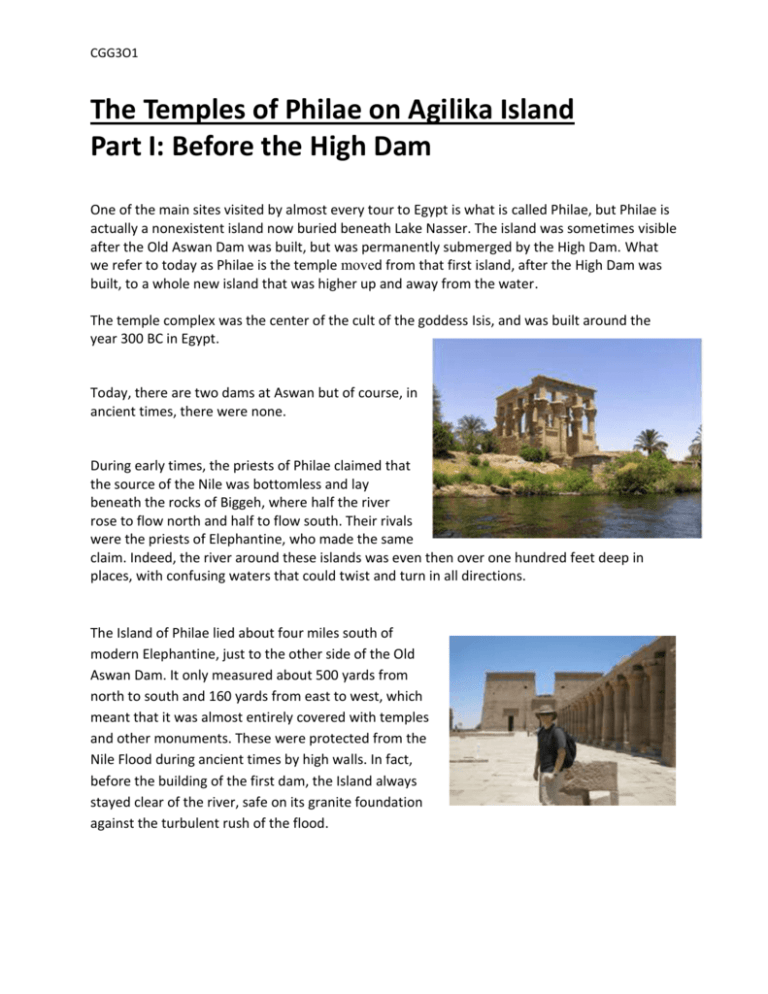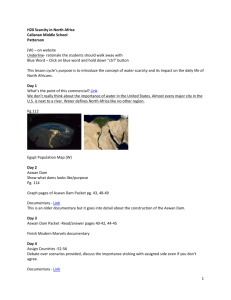File
advertisement

CGG3O1 The Temples of Philae on Agilika Island Part I: Before the High Dam One of the main sites visited by almost every tour to Egypt is what is called Philae, but Philae is actually a nonexistent island now buried beneath Lake Nasser. The island was sometimes visible after the Old Aswan Dam was built, but was permanently submerged by the High Dam. What we refer to today as Philae is the temple moved from that first island, after the High Dam was built, to a whole new island that was higher up and away from the water. The temple complex was the center of the cult of the goddess Isis, and was built around the year 300 BC in Egypt. Today, there are two dams at Aswan but of course, in ancient times, there were none. During early times, the priests of Philae claimed that the source of the Nile was bottomless and lay beneath the rocks of Biggeh, where half the river rose to flow north and half to flow south. Their rivals were the priests of Elephantine, who made the same claim. Indeed, the river around these islands was even then over one hundred feet deep in places, with confusing waters that could twist and turn in all directions. The Island of Philae lied about four miles south of modern Elephantine, just to the other side of the Old Aswan Dam. It only measured about 500 yards from north to south and 160 yards from east to west, which meant that it was almost entirely covered with temples and other monuments. These were protected from the Nile Flood during ancient times by high walls. In fact, before the building of the first dam, the Island always stayed clear of the river, safe on its granite foundation against the turbulent rush of the flood. CGG3O1 Prior to the building of the Aswan Dam, the engineer in charge, Captain Henry Lyon, was asked to underpin the monuments of Philae so that they could withstand the submersion, which he did. After the Old Dam was built, it created a lake extending south some 140 miles back to the Sudanese border. In fact, the height of the dam was at first restricted because of the protests made by people interested in preserving Philae and the other temples and monuments from submersion. So the water level was raised, and the temples and structures on Philae were flooded each year from December to about March, and had to be visited during this time by boat. All did not turn out as badly as thought, however. The water ended up saving the temples from erosion by sand storms and helped to remove salt deposits which were damaging to the stonework. Regular inspections of the site showed that it suffered less damage than might have been expected, save for the paintwork that was washed away by the new lake created by the Old English Dam. Then, construction on the High Dam (the second dam) began and, as with a number of other monuments south of Aswan, the temple and other monuments had to either be moved or lost beneath the waters. In reality, Philae would not have been lost under the water of Lake Nasser itself, but rather the new lake that was formed between the High Dam and the Old Dam. It was the only major monument located in this region. It would have been almost permanently submerged, but worse, this small lake is subject to a daily rise and fall of several yards, which would have inevitably eroded the temples completely. During the 1970s the Philae monuments were moved to the island of Agilkia, just northwest of Philae Island. Since waters already engulfed the monuments at Philae, a dam had to be built around the island and then the water pumped out. This work began in 1972 and was finished in 1980 as a cooperative effort of UNESCO and the Egyptian Antiquity Organization. The new location was carefully landscaped to make it resemble Philae as much as possible. Some 40,000 blocks, weighing about 20,000 tons were moved to the new location. CGG3O1 Questions 1. What is Philae? What does the name Philae refer to today? 2. When and why was this temple complex built? 3. How were the temples protected from the flooding Nile in ancient times? 4. Name 2 things that happened when the Old Dam was built. 5. What positive effects did the flood actually have on the temple? 6. What would happen to Philae when they built the High Dam? 7. What solution did they come up with? CGG3O1 Personal Opinion Paragraph It took 8 years and cost many millions of dollars to move and rebuild the entire temple complex of Philae. Not to mention the cost of maintaining such an old structure. Do you think we should be spending so much money on saving old buildings and landmarks? There are many poor people in Egypt; that money could have instead gone to help them. Or is it more important to preserve these cultural sites for future generations? Write a paragraph response to this question. Try to be specific and give examples.







